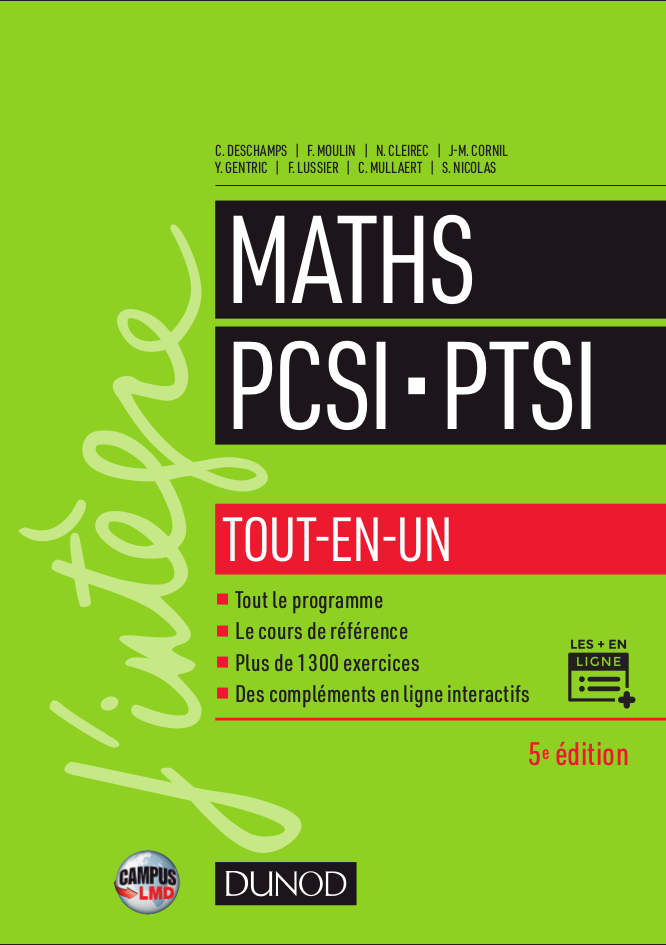Il faut savoir exprimer les solutions (complexes) de l'équation $z^{2n}=-1$.
Un complexe $z=\rho\,e^{i\theta}$ vérifie $z^{2n}=-1= e^{i\pi}$ si, et seulement si :
\[
\rho^{2n} = 1 \et 2n\,\theta \equiv \pi \;[2\pi]
\]
ce qui équivaut à dire qu'il existe $k\in\ceo 0,2n-1\cef$ tel que :
\[
z = \exp\Big(\frac{i\pi}{2n}+\frac{2k i \pi}{2n}\Big) = \exp\Big(\frac{(2k+1)i \pi}{2n}\Big).
\]
Remarque En fait, on peut faire varier $k$ sur tout intervalle d'entiers de cardinal $2n$,
et ici il est préférable de prendre $k \in\ceo -n,n-1\cef $.
Voir éventuellement le chapitre sur les complexes et, plus précisément, la partie sur les racines de l'unité.
Il faut aussi savoir simplifier une quantité du genre $\ds\frac{\exp(i\theta)-1}{\exp(i\theta)+1}\cdot$
En mettant $\exp\big(\frac{i\theta}{2}\big)$ en facteur, puis en utilisant $\ldots$
$\ldots$ les formules d'Euler.
Après justification, écrire l'équation sous la forme $\ds \Big(\frac{1+i\,x}{1-i\,x}\Big)^{2n}=-1$.
L'équation $S_n(x)=0$ s'écrivant :
\[
(1+i\,x)^{2n} = - (1-i\,x)^{2n}
\]
et n'ayant évidemment pas $-i$ comme racine, elle est équivalente à :
\[
\Big(\frac{1+i\,x}{1-i\,x}\Big)^{2n}=-1.
\]
Par suite, $x$ en est solution si, et seulement si, il existe $k\in\ceo -n,n-1\cef$ vérifiant :
\[
\frac{1+i\,x}{1-i\,x} = \exp\Big(\frac{(2k+1) i \pi}{2n}\Big), \tag{$E_k$}
\]
l'équation $(E_k)$ étant équivalente à :
\[
(1+i\,x) = (1-i\,x)\exp\Big(\frac{(2k+1) i \pi}{2n}\Big)
\]
et donc à :
\[
i\,x \bigg(1+\exp\Big(\frac{(2k+1) i \pi}{2n}\Big)\bigg) = \exp\Big(\frac{(2k+1) i \pi}{2n}\Big)-1.
\]
Comme le complexe $\exp\Big(\frac{(2k+1) i \pi}{2n}\Big)$ est une racine $2n$e de $-1$,
il ne peut être égal à $-1$, et $(E_k)$ a donc comme seule solution :
\begin{align*}
x &= \frac{1}{i}\,\frac{\exp\Big(\frac{(2k+1) i \pi}{2n}\Big)-1}{1+\exp\Big(\frac{(2k+1) i \pi}{2n}\Big)}\\\\
& =\frac{1}{i}\, \frac{\exp\Big(\frac{(2k+1) i \pi}{4n}\Big)-\exp\Big(-\frac{(2k+1) i \pi}{4n}\Big)}
{\exp\Big(-\frac{(2k+1) i \pi}{4n}\Big)+\exp\Big(\frac{(2k+1) i \pi}{4n}\Big)}\\\\
&=\tan\Big(\frac{(2k+1)\pi}{4n}\Big)\cdot
\end{align*}
Étant donné que pour les $2n$ valeurs de $k$ de l'intervalle $\ceo -n,n-1\cef$, on a :
\[
-\frac{\pi}{2} < -\frac{(2n-1)\pi}{4n} \leq \frac{(2k+1)\pi}{4n} \leq \frac{(2n-1)\pi}{4n} < \frac{\pi}{2}
\]
et que la fonction tangente est strictement croissante sur $\mathopen{]}-\frac{\pi}{2},\frac{\pi}{2}\mathclose{[}$,
on en déduit que l'équation donnée possède $2n$ racines qui sont :
\[
x_k = \tan\Big(\frac{(2k+1)\pi}{4n}\Big) \avec k\in \ceo -n,n-1\cef.
\]
